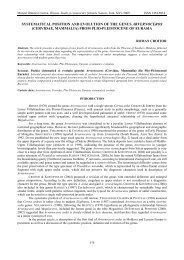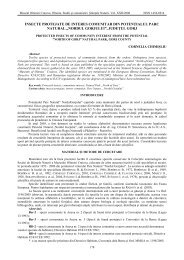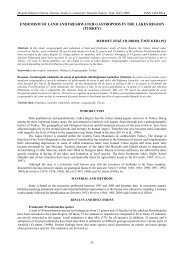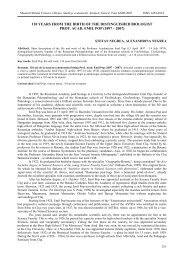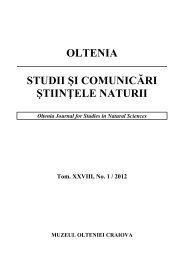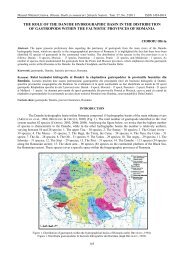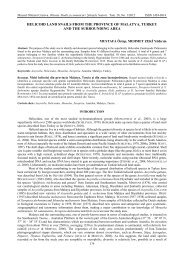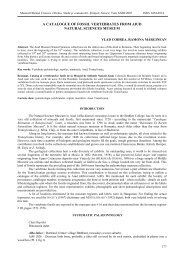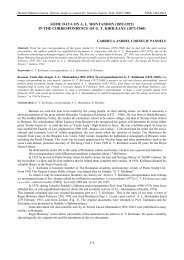contribution to the study of maeotian hipparion faunas from the ...
contribution to the study of maeotian hipparion faunas from the ...
contribution to the study of maeotian hipparion faunas from the ...
You also want an ePaper? Increase the reach of your titles
YUMPU automatically turns print PDFs into web optimized ePapers that Google loves.
Muzeul Olteniei Craiova. Oltenia. Studii i comunicri. tiinele Naturii, Tom. XXV/2009 ISSN 1454-6914<br />
CONTRIBUTION TO THE STUDY OF MAEOTIAN HIPPARION FAUNAS FROM THE<br />
REPUBLIC OF MOLDOVA<br />
391<br />
ANDRIAN DELINSCHI<br />
Abstract. The present work deals with <strong>the</strong> faunal structure and taphonomy <strong>of</strong> several Meotian <strong>faunas</strong> with Hipparion <strong>from</strong> <strong>the</strong><br />
Upper Miocene <strong>of</strong> <strong>the</strong> Republic <strong>of</strong> Moldova. According <strong>to</strong> <strong>the</strong> local stratigraphic scale <strong>of</strong> continental formations, <strong>the</strong>se Meotian<br />
faunal associations can be correlated with <strong>the</strong> Lower and Middle Turolian (MN11-12 biozones) <strong>of</strong> European Land Mammal Ages.<br />
Keywords: Hipparion fauna, Upper Miocene, Republic <strong>of</strong> Moldova.<br />
Rezumat. Unele studii cu privire la siturile faunei meoiene cu Hipparion din Republica Moldova. În aceast lucrare<br />
sunt specificate unele informaii cu privire la componena sistematic a asociaiilor faunistice i tafonomia siturilor faunei cu<br />
Hipparion din Miocenul superior, care sunt atribuite diferi<strong>to</strong>r nivele stratigrafice ale Meoianului din Republica Moldova. Conform<br />
scrii stratigrafice a formaiunilor geologice continentale, vârstele asociaiilor faunistice din Meoian sunt atribuite Turolianului<br />
inferior i mediu (biozonele MN11-12).<br />
Cuvinte cheie: Fauna cu Hipparion, Miocenul superior, Republica Moldova.<br />
According <strong>to</strong> ROSCA & HUBKA (1986), Meotian continental formations are represented by strata (up <strong>to</strong> 290 m<br />
thick) <strong>of</strong> continental unstratified clay with aleurite prolayers and fine-grained sands, which are known as <strong>the</strong> Cahul<br />
Formation. Deposits ascribed <strong>to</strong> this formation include important sites <strong>of</strong> Hipparion fauna such as: Ciobruciu, Tudora,<br />
Taraclia, Cimislia, Gura-Galbenei.<br />
Ciobruciu, Stefan-Voda district. The site is located on <strong>the</strong> right bank <strong>of</strong> <strong>the</strong> Dniester River, at <strong>the</strong> western<br />
borders <strong>of</strong> Ciobruciu village.<br />
Stratigraphic position, taphonomy, faunal determinations and descriptions have been already studied by<br />
PAVLOW (1913, 1914), GABUNIJA (1959), LUNGU (2001), and LUNGU & DELINSCHI (2006).<br />
In Ciobruciu section, marine sediments <strong>of</strong> <strong>the</strong> Khersonian substage are overlain by 40 <strong>to</strong> 45 m thick sandyargillaceous<br />
sediments referred <strong>to</strong> as <strong>the</strong> Balta Formation. According <strong>to</strong> <strong>the</strong> stratigraphic data and lithology, <strong>the</strong>se<br />
continental sediments, represent lacustrine, fluviatile, and deltaic facies.<br />
Gabunija (1959) listed <strong>the</strong> following terrestrial vertebrates <strong>from</strong> this site:<br />
Reptilia: Protestudo bessarabica RJABININ, 1918;<br />
Mammalia. Edentata: Orycteropus gaudryi F. MAJOR, 1888;<br />
Carnivora: Mustela palaeatica WEITHOFER, 1888, Icti<strong>the</strong>rium viverinum ROTH & WAGNER, 1854, Adcrocuta<br />
eximia (ROTH et WAGNER, 1854), Machairodus schlosseri WEITHOFER, 1888, Machairodus cultridens CUVIER, 1824,<br />
Simocyon primigenius WAGNER, 1832;<br />
Proboscidae: Choerolophodon pentelici (GAUDRY & LARTET, 1856), Mas<strong>to</strong>don sp., Deino<strong>the</strong>rium giganteum<br />
KAUP, 1829;<br />
Perissodactyla: Hipparion cf. verae GABUNIA, 1979, Hipparion cf. moldavicum GROMOVA, 1952,<br />
Acera<strong>the</strong>rium incisivum KAUP, 1832, Dihoplus schleiermacheri (KAUP, 1832);<br />
Artiodactyla: Cervus sp., Palaeotragus rouenii GAUDRY, 1861, Palaeotragus sp., Hellado<strong>the</strong>rium duvernovi<br />
GAUDRY et LARTET, 1856, Tragoportax frolovi PAVLOW, 1913, ?Palaeoryx stützeri SCHLOSSER, 1905, Gazella<br />
deperdita GERVAIS, 1847.<br />
Gabunija (1959) defines <strong>the</strong> age <strong>of</strong> Ciobruciu fauna as Lower Meotian, an opinion shared by LUNGU &<br />
DELINSCHI (2006), and DELINSCHI (2008). ROTKEVICH (1988) considered this site as Upper Khersonian.<br />
Since 1987-2006, new excavations in Ciobruci site unear<strong>the</strong>d very interesting palaeon<strong>to</strong>logical material <strong>of</strong><br />
small terrestrial vertebrates (LUNGU, 1990, 2001, LUNGU & DELINSCHI, 2006, DELINSCHI, 2008).<br />
Taphonomy. Remains <strong>of</strong> vertebrates were collected <strong>from</strong> argillaceous sands underlying Quaternary fluviatile<br />
terraces <strong>of</strong> <strong>the</strong> Dniester. Bone remains are homogeneously distributed within <strong>the</strong> deposits and <strong>the</strong>y do not form<br />
accumulations. They show different degrees <strong>of</strong> rolling, fossilization, and colour. Gabunija (1959) thought that fossil<br />
remains <strong>of</strong> Ciobruci were brought by water in swampy river bank conditions, covered by willow and alder, while some<br />
specimens originate <strong>from</strong> more remote steppe and semi-steppe sites. Judging by lithology, bedding pattern, and<br />
fossilization, <strong>the</strong> burial area should represent a deltaic region <strong>of</strong> a Meotian river.<br />
This site yielded remains <strong>of</strong> <strong>the</strong> following taxa <strong>of</strong> terrestrial vertebrates (LUNGU & DELINSCHI, 2006):<br />
Amphibia: Mioproteus cf. caucasicus ESTES & DAREVSKI, 1977, Rana sp.;<br />
Reptilia: Cheledropsis sp., Melanochelis sp., Sakya sp., Protestudo sp., Lacerta sp., Ophisaurus sp., Natris sp.,<br />
Elaphe sp., Vipera sp;<br />
Aves: Struthio sp., Anas sp.;<br />
Mammalia. Insectivora: Desmana sp., Soriciculus sp., Amblicoptus sp.;
ANDRIAN DELINSCHI<br />
Lagomorpha: Proocho<strong>to</strong>na eximia CHOMENKO, 1914;<br />
Rodentia: Spermophilinus cf. bredai-turolensis DAXNER-HÖCK, 1975, Myomimus dehmi (DE BRUIJN, 1966),<br />
Vasseuromys cf. <strong>the</strong>nii DAXNER-HÖCK & DE BRUIJN, Hansdebruijnia neutrum, (DE BRUIJN, 1976), Valerimys sp.,<br />
Neocrice<strong>to</strong>don (Kowalskia) cf. lavocati (HUGUENEY & MEIN, 1965);<br />
Carnivora: Icti<strong>the</strong>rium sp.;<br />
Perissodactyla: Hipparion sp., Acera<strong>the</strong>rium sp.;<br />
Artiodactyla: Cervavitus sp., Tragoportax amal<strong>the</strong>us GAUDRY, 1861.<br />
The fauna <strong>of</strong> Ciobruciu indicates <strong>the</strong> presence <strong>of</strong> different biocoenoses. The occurrence <strong>of</strong> Proocho<strong>to</strong>na cf.<br />
eximia, Vasseuromys cf. <strong>the</strong>nii, Hansdebruijnia cf. neutrum, Valerimys sp., Neocrice<strong>to</strong>don cf. lavocati, Hipparion cf.<br />
moldavicum etc. confirms a lower Meotian age that can be attributed <strong>to</strong> <strong>the</strong> Early Turolian (biozone MN11).<br />
araclia, Causeni district. The site is located at <strong>the</strong> northwestern margin <strong>of</strong> Taraclia village, 25 km South <strong>of</strong><br />
Tighina city. It is one <strong>of</strong> <strong>the</strong> largest sites <strong>of</strong> Hipparion fauna <strong>from</strong> Meotian (Turolian) in <strong>the</strong> Eastern Europe.<br />
Lithology and stratigraphy indicate alluvial-lacustrine deposits <strong>of</strong> <strong>the</strong> Cahul Formation overlying marine<br />
sediments <strong>of</strong> Kersonian (Upper Sarmatian) age.<br />
aphonomy. In this section CHOMENKO (1913) distinguished seven bone lenses (I-VII), up <strong>to</strong> two meters<br />
wide, and 0.3-0.5 m thick, interrupted by 0.2-0.3 m thick unfossiliferous beds. The lithological features <strong>of</strong> <strong>the</strong> bone<br />
lenses, <strong>the</strong> absence <strong>of</strong> a coarse-grained material, <strong>the</strong> uniform orientation <strong>of</strong> bones in<strong>to</strong> <strong>the</strong> layers, indicate <strong>the</strong>ir<br />
accumulation by a slowly flowing river. The burial zone possibly represented <strong>the</strong> delta <strong>of</strong> a Meotian river.<br />
The distribution pattern <strong>of</strong> bones and <strong>the</strong>ir arrangement in lenses indicates variable water energy in streams<br />
transporting <strong>the</strong> animal remains.<br />
The presence <strong>of</strong> articulated postcranial bones, skulls and mandibles and rounded bone fragments evidences <strong>the</strong><br />
transportation <strong>of</strong> bones <strong>from</strong> sites at different distance <strong>from</strong> <strong>the</strong> burial. Turbulent streams could rumple and shatter <strong>the</strong><br />
bones.<br />
Large bone fragments indicate a considerable initial speed <strong>of</strong> water streams. It is probable that smaller bones<br />
were transported <strong>from</strong> more distant locations. When water speed decreased, only small bones fragments could be<br />
transported <strong>to</strong> <strong>the</strong> burial.<br />
The presence <strong>of</strong> seven bone lenses in <strong>the</strong> section points <strong>to</strong> a long duration <strong>of</strong> <strong>the</strong> locality formation. Seasonal<br />
severe rainfalls could produce strong water streams that transported and deposited bone remains in <strong>the</strong> delta and<br />
floodplain <strong>of</strong> a Meotian river.<br />
Non-uniform distribution <strong>of</strong> atmospheric precipitation might be responsible for <strong>the</strong> formation <strong>of</strong> <strong>the</strong> Taraclia<br />
vertebrate locality; droughts or catastrophic rainfalls could be among <strong>the</strong> causes <strong>of</strong> animals’ deaths.<br />
The fauna <strong>of</strong> Taraclia was studied by CHOMENKO (1913, 1914). Some forms <strong>of</strong> this faunal association are also<br />
described by RYABININ (1929), GROMOVA (1952), TROFIMOV (1954), and GODINA (1979).<br />
The list <strong>of</strong> <strong>the</strong> Taraclia fauna includes:<br />
Reptilia: Protestudo bessarabica RJABININ, 1918;<br />
Mammalia. Lagomorpha: Proocho<strong>to</strong>na exima, CHOMENKO 1914; Alilepus lascarevi (CHOMENKO, 1914)<br />
Rodentia: Cas<strong>to</strong>r cf. praefiber LINNE, 1902; Hystrix bessarabica RJABININ, 1918;<br />
Carnivora: Martes leporinum (CHOMENKO, 1914); Hyaenicti<strong>the</strong>rium vena<strong>to</strong>r SEMENOV, 1989; Icti<strong>the</strong>rium<br />
viverinum ROTH et WAGNER, 1854; Lycyaena choeretis (GAUDRY, 1862); Thalassictis parvum (CHOMENKO, 1914);<br />
Adcrocuta exima (ROTH et WAGNER, 1854); Felis attica WAGNER, 1857; Paramachairodus orientalis GAUDRY, 1862;<br />
Metailurus parvulus (HENSEL, 1862); Machairodus giganteus (WAGNER, 1857).<br />
Proboscidea: Deino<strong>the</strong>rium giganteum KAUP., 1829; Tetralophodon longirostris (KAUP, 1832), Zygolophodon<br />
turicensis (SCHINZ, 1824)<br />
Perisodactyla: Hipparion moldavicum GROMOVA, 1952; Hipparion platygenis GROMOVA, 1952; Acera<strong>the</strong>rium<br />
incisivum KAUP, 1832; Diceros pachygnathus (WAGNER, 1848); Dihlopus orientalis (SCHLOSSER, 1921);<br />
Artiodactyla: Micros<strong>to</strong>nyx major (GERVAIS, 1848-1852); Cervavitus novorossiae CHOMENKO, 1913;<br />
Palaeotragus rouenii GAUDRY, 1881; Samo<strong>the</strong>rium boissieri F. MAJOR, 1888; Hellado<strong>the</strong>rium duvernovi (GAUDRY &<br />
LARTET, 1856); ?Camelopardalis sp.; Tragoportax amal<strong>the</strong>a (ROTH. & WAGNER, 1854); Tragoportax amal<strong>the</strong>a var<br />
parvidens (SCHLOSSER, 1904); Tragoportax rugosiforms (SCHLOSSER, 1904); ?Tragoportax validus (CHOMENKO,<br />
1913); Palaeorix majori SCHLOSSER, 1904; Palaeorix stutzeri SCHLOSSER, 1904; Tragoreas oryxoides SCHLOSSER,<br />
1904; Protragelaphus skouzesi DAMES, 1883; Procapra rodleri (PILGRIM & HOPWOOD, 1928); Pseudotragus<br />
capricorns SCHLOSSER, 1904; Gazella deperdita GERVAIS, 1848; Gazella capricornis WAGNER, 1854; Crio<strong>the</strong>rium<br />
argalioides F. MAJOR, 1891; Procobus brauneri CHOMENKO, 1913; Procobus melania CHOMENKO, 1913;<br />
The distinctive feature <strong>of</strong> <strong>the</strong> Taraclia fauna is <strong>the</strong> presence <strong>of</strong> diverse antelopes, widespread in <strong>the</strong> Turolian in<br />
<strong>the</strong> eastern Mediterranean.<br />
GABUNJA (1959) and DELINSCHI (2008) correlated <strong>the</strong> fauna with Middle Meotian. The fauna <strong>from</strong> araclia<br />
has a Turolian aspect. It can be attributed <strong>to</strong> <strong>the</strong> Middle Turolian (zone MN 12) <strong>of</strong> <strong>the</strong> European continental<br />
stratigraphic scale.<br />
392
Muzeul Olteniei Craiova. Oltenia. Studii i comunicri. tiinele Naturii, Tom. XXV/2009 ISSN 1454-6914<br />
Cimislia. The site is located on <strong>the</strong> right banks <strong>of</strong> <strong>the</strong> Kogylnik River, near <strong>the</strong> <strong>to</strong>wn <strong>of</strong> Cimislia. A dense<br />
ravine network covers an area <strong>of</strong> about 100 hectares. The ravines expose (at about 90 m a.s.l.) bone-bearing beds. There<br />
are al<strong>to</strong>ge<strong>the</strong>r 11 fossiliferous sites in <strong>the</strong> fluviatile-lacustrine deposits <strong>of</strong> <strong>the</strong> Balta Formation.<br />
phonomy. Bone remains <strong>of</strong> terrestrial vertebrates occur in sands and clays <strong>of</strong> channel and floodplain<br />
alluvial facies. Bone concentrations <strong>of</strong> 1.0 by 1.5 m form local bone breccia lenses. A rapid burial is indicated by <strong>the</strong><br />
chaotic bone arrangement. The material includes articulated bones, vertebrae, skulls with mandibles, and sporadic rolled<br />
bone fragments. It is possible that strong temporary water currents transported floating, not decomposed corpses, and as<br />
separate parts. Bones were buried in channel and floodplain settings <strong>of</strong> a Meotian river. Animals could have died as a<br />
result <strong>of</strong> flooding or drought.<br />
The Cimislia fauna (BARBU, 1959, BELIJAEVA, 1948, LUNGU &, ARABUKIN, 1966, RABUKIN, 1968,<br />
LUNGU & DELINSCHI, 2008, DELINSCHI, 2005, 2008) includes:<br />
Reptilia: Protestudo bessarabica (RJABININ, 1918);<br />
Aves: Struthio sp.;<br />
Mammalia. Insectivora: Erinaceus sp.;<br />
Logomorpha: Alilepus lascarevi (CHOMENKO, 1914).;<br />
Rodentia: Hystryx sp.;<br />
Carnivora: Promeles palaeattica (WEITHOFER, 1888), Eomellivora rumana Simionescu, 1938,<br />
Miochyaeno<strong>the</strong>rium bessarabicum (SIMIONESCU 1938), Thalassictis parvum (CHOMENKO, 1914), Adcrocuta eximia<br />
(ROTH et WAGNER, 1854), Machairodus giganteus (WAGNER, 1857), Paramachoirodus orientalis GAUDRY, 1862,<br />
Acinonys sp., Felis sp.;<br />
Proboscidea: Tetralophodon aff. atticus (WAGNER, 1857), Zygolophodon turicensis (SCHINZ, 1824),<br />
Deino<strong>the</strong>rium giganteum KAUP, 1829;<br />
Perissodactyla: Hipparion praegiganteum TARABUKIN, 1968, Hipparion moldavicum, GROMOVA, 1952,<br />
Hipparion mat<strong>the</strong>wi ABEL, 1926, Acera<strong>the</strong>rium incisivum KAUP, 1832, Dihoplus aff pikermiensis TOULA, 1906,<br />
Chilo<strong>the</strong>rium schosseri (WEBER, 1905), Acerorhinus sp.;<br />
Artiodactyla: Micros<strong>to</strong>nyx major (GERVAIS, 1848-1852), Cervavitus variabilis ALEXEJEW 1915, Cervavitus<br />
novorossiae CHOMENKO 1913, Palaeotragus rouenii GAUDRY, 1861, Hellado<strong>the</strong>rium suchovi (GODINA, 1977),<br />
Miogazella pilgrimi (BOHLIN, 1935), Vetaprocapra capricornis (PILGRIM, HOPWOOD, 1928) Tragoportax frolovi<br />
(PAVLOW, 1913), Palaeoryx aff. pallasi WAGNER, 1857, Palaeoreas lindermayeri WAGNER, 1848.<br />
The fauna <strong>from</strong> Cimislia is one <strong>of</strong> <strong>the</strong> richest Hipparion <strong>faunas</strong> <strong>from</strong> Eastern Europe, but systematics <strong>of</strong> many<br />
taxa need a revision. Forms <strong>of</strong> open, savannah-like bio<strong>to</strong>pes dominate in this fauna.<br />
Recently, a new locality <strong>of</strong> terrestrial vertebrates was discovered in <strong>the</strong> quarry at <strong>the</strong> nor<strong>the</strong>rn margin <strong>of</strong><br />
Cimislia city (at <strong>the</strong> absolute elevation <strong>of</strong> 80 m). Bones occur in alluvial sediments <strong>of</strong> <strong>the</strong> Balta Formations (Delinschi<br />
2005, 2008).<br />
The bed <strong>of</strong> coarse-grained sand is exposed at <strong>the</strong> basis <strong>of</strong> <strong>the</strong> section. This bed contains intercalations <strong>of</strong> marl<br />
gravel and microconglomerate, which contains bones <strong>of</strong> small terrestrial vertebrates. They are overlain by clayey crossbedded<br />
sands grading <strong>to</strong> compact clay.<br />
These sediments account for a uniform alluvial sedimentation cycle, combining channel and meadow river<br />
facies. The following forms have been recorded <strong>from</strong> this site (DELINSCHI, 2008):<br />
Reptilia: Protestudo sp., Ophisaurus sp., Lacerta sp., Vipera sp.;<br />
Mammalia. Chiroptera: gen. et sp. inden.;<br />
Insectivora: Parasorex socialis (VON MEYER, 1865), ?Erinaceus sp., Ruemkelia sp.<br />
Logomorpha: Alilepus lascarevi (CHOMENKO, 1914).;<br />
Rodentia: Tamias atsali DE BRUIJN, 1995, Euroxenomys minutum rhenanum (FRAZEN & STORCH, 1975),<br />
Myomimus maritsensis DE BRUIJN, DAWSON & MEIN, 1970, Vasseuromis sp., Lophocricetus minuscilus SAVINOV,<br />
1977, Neocrice<strong>to</strong>don (Kowalskia) browni DAXNER-HOCK, 1992, Neocrice<strong>to</strong>don (Kowalskia) sp., Pseudocricetus<br />
orienteuropaeus TOPACEVSKI et SCORIK, 1992, Hansdebruijnia aff. neutrum (DE BRUIJN, 1976), Apodemus aff.<br />
barbarae (VAN DE WEERD, 1976);<br />
Remains <strong>of</strong> murids and cricetids (Muridae and Cricetidae) dominate in <strong>the</strong> fauna.<br />
Cimislia fauna is correlated with <strong>the</strong> Upper Meotian, but its taxonomic composition evidences a younger age<br />
than that <strong>of</strong> Cioburciu and probably raclia sites.<br />
Cimislia fauna is dated <strong>to</strong> <strong>the</strong> later part <strong>of</strong> <strong>the</strong> Meotian (Middle Turolian, upper part <strong>of</strong> N12 or MN12-13<br />
boundary.<br />
Gura-Galbenei, Cimislia district.<br />
The site is situated in <strong>the</strong> Kogylnik River valley, at <strong>the</strong> eastern margin <strong>of</strong> Gura-Galbenei village, 20 km N <strong>of</strong><br />
Cimislia city.<br />
The outcrop exposes a 50 m thick member <strong>of</strong> grey-green compact clay alternating with fine-grained quartzmicaceous<br />
sand <strong>of</strong> lacustrine-alluvial origin. These sediments, referred <strong>to</strong> as Balta Formations, show a rhythmic<br />
structure with several alluvial cycles. Each cycle begins with medium-grained quartz-micaceous sands grading upwards<br />
<strong>to</strong> fine-grained sands, covered by compact clays.<br />
393
ANDRIAN DELINSCHI<br />
The geological age <strong>of</strong> <strong>the</strong> locality is under discussion. By stratigraphic position and taphonomic features, Gura-<br />
Galbenei should be quite similar <strong>to</strong> <strong>the</strong> Cimislia site.<br />
According <strong>to</strong> SUHOV (1945), KONIKOV (1957), and DELINSCHI (2008) <strong>the</strong> faunal association <strong>from</strong> Gura-<br />
Galbenei includes <strong>the</strong> following forms:<br />
Mammalia. Lagomorpha: Alilepus sp.<br />
Carnivora: Machairodus sp.<br />
Proboscidea: Mammut borsoni (HAYS, 1834)<br />
Perissodactyla: Hipparion sp., Chilo<strong>the</strong>rium schlosseri (WEBER, 1905), Acera<strong>the</strong>rium incisivum KAUP, 1832.<br />
Artiodactyla: Micros<strong>to</strong>nyx major (GERVAIS, 1848-1852), Cervavitus variabilis ALEXEJEW, 1915,<br />
Hellado<strong>the</strong>rium duvernoyi GAUDRY & LARTET, 1856, Gazella deperdita GERVAIS, 1847<br />
Tudora, Stefan Voda district<br />
The site is located on <strong>the</strong> right bank <strong>of</strong> <strong>the</strong> Dniester River, at <strong>the</strong> northwestern margin <strong>of</strong> Tudora village.<br />
Taphonomy. As shown by bones occurrence in compact clays and fine-grained clayey sands<strong>to</strong>nes, and in<br />
humus clays, <strong>the</strong> burial is associated with a shallow water basin <strong>of</strong> lacustrine or estuary type. Sands intercalations and<br />
sporadic pebbles indicate temporary currents as <strong>the</strong> accumulation agent <strong>of</strong> <strong>the</strong> animal remains.<br />
Krokos (1914) noted <strong>the</strong> presence in <strong>the</strong> bone bed <strong>of</strong> a leaf flora including Salix, Ulmus, Populus and o<strong>the</strong>r<br />
forms that evidence a damp temperate climate.<br />
Tudora fauna was described by PAWLOV (1913, 1914), KROKOS (1916), and GABUNIJA (1959).<br />
According <strong>to</strong> BELJAEVA (1948) and DELINSCHI (2008), <strong>the</strong> faunal association <strong>from</strong> udora includes <strong>the</strong><br />
following forms:<br />
Reptila: Protestudo bessarabica (RJABININ, 1918),<br />
Mammalia Carnivora: Adcrocuta exima (ROTH & WAGNER, 1854);<br />
Perissodactila: Hipparion tudorovense GABUNIA, 1959,<br />
Acera<strong>the</strong>rium incisivum KAUP, 1932, Acera<strong>the</strong>rium simplex (KROKOS, 1914)<br />
Artiodactyla: Micros<strong>to</strong>nyx aff. major GERVAIS (1848-1852), Tragoportax amal<strong>the</strong>us (GAUDRY, 1861)<br />
Palaeoryx majori SCHLOSSER, 1904, Gazella deperdita GERVAIS, 1848.<br />
The majority <strong>of</strong> <strong>the</strong> forms <strong>of</strong> Tudora fauna are common in <strong>the</strong> Meotian faunal associations <strong>from</strong> Moldova and<br />
Ukraine. The fauna also includes a new form <strong>of</strong> Hipparion (H. tudorovense) and a rhinoceros (Acera<strong>the</strong>rium simplex).<br />
Based on <strong>the</strong>se data, Gabunija (1959) dated Tudora fauna at <strong>the</strong> Upper Meotian. This is in agreement with <strong>the</strong> local<br />
geology as continental fossiliferous formations overlain by marine sediments <strong>of</strong> <strong>the</strong> Lower Pontian.<br />
The fauna <strong>from</strong> <strong>the</strong> Tudora locality is poorly studied. Until recently, it was considered younger than those <strong>from</strong><br />
Cimislia, and it was correlated with <strong>the</strong> upper part <strong>of</strong> MN12 or lower part <strong>of</strong> MN13. In this case, <strong>faunas</strong> <strong>of</strong> Cimislia and<br />
Tudora are synchronous or <strong>the</strong> Tudora fauna may have Early Pontian age.<br />
CONCLUSIONS<br />
Fossil Hipparion fauna <strong>of</strong> <strong>the</strong> Meotian age occur in Moldova in deltaic and lacustrine-alluvial facies<br />
frequently forming large lense-like concentrations.<br />
Meotian faunal associations have a Turolian aspect possibly attributable <strong>to</strong> mammal zones MN11-MN13.<br />
In <strong>the</strong> Late Miocene, <strong>the</strong> area <strong>of</strong> <strong>the</strong> modern Moldova was situated at <strong>the</strong> boundary between different<br />
palaeobiogeographic provinces that influenced <strong>the</strong> formation and evolution <strong>of</strong> <strong>the</strong> local <strong>the</strong>ri<strong>of</strong>auna.<br />
REFERENCES<br />
BARBU V. 1959. Contribuii la cunoaterea genului Hipparion (Studies on <strong>the</strong> genus Hipparion). Editura Academiei<br />
Republicii Populare Române. Bucureti: 1-83.<br />
BELIJAEVA E. 1948. Katalog mes<strong>to</strong>nachoždenij tretinych nazemnych mlekopitajušich na terri<strong>to</strong>rii SSSR (Catalogue <strong>of</strong><br />
<strong>the</strong> Tertiary terrestrial mammal localities in <strong>the</strong> Soviet Union). Trudy Paleon<strong>to</strong>logieskogo Instituta Akademii<br />
Nauk SSSR 15(3): 36-116. (in Russian).<br />
CHOMENKO J. 1913. Meotieskaja fauna sela Taraklija Benderskogo uezda. Ežegodnik po geologii i Miner. Rossii. XV,<br />
V 4-6: 107-143. (in Russian).<br />
CHOMENKO J. 1914. La faune mèotique du village Taraklia du district de Bendery. Trav. de la Sci. Nat. de Bessarabie.<br />
V: 1-65. (in Franch).<br />
DELINSCHI A. 2005. Stadiul de cunoatere a vertebratelor meoiene de pe Platforma Moldoveneasc. Referat doc<strong>to</strong>rat.<br />
BCU Iai: 3-34.<br />
DELINSCHI A. 2008. Studiul faunei de microvertebrate din partea de Sud a Republicii Moldova. PhD Thesis. Iasi: 4-<br />
222.<br />
GABUNIJA L. 1959. K is<strong>to</strong>rii gipparionov (po materialu iz neogena SSSR) [The Hipparion his<strong>to</strong>ry (according <strong>to</strong> SSSR<br />
Neogene material)]. Izdatelstvo Akademii Nauk SSSR. Moskva: 5-565. (in Russian).<br />
GODINA A. 1979. His<strong>to</strong>rical Developman <strong>of</strong> giraffieds. The genus Palaeotragus. Nauka. Moskow: 3-115. (in Russian).<br />
394
Muzeul Olteniei Craiova. Oltenia. Studii i comunicri. tiinele Naturii, Tom. XXV/2009 ISSN 1454-6914<br />
GROMOVA V. 1952. G<strong>hipparion</strong>i (Rued Hipparion). Trudy Paleon<strong>to</strong>logicheskogo Instituta AN SSSR. 36. (in Russian).<br />
KOROTKEVIC E. 1988. Is<strong>to</strong>rija formirovanija gipparionovoj fauny wos<strong>to</strong>noj Evropy (His<strong>to</strong>ry <strong>of</strong> formation <strong>of</strong> <strong>the</strong><br />
Hipparion fauna in Eastern Europe). Kiev. Naukova Dumka: 3-160. (in Russian).<br />
KONIKOVA N. 1957. On <strong>the</strong> development <strong>of</strong> earth vertebrates in <strong>the</strong> Upper Miocene <strong>of</strong> <strong>the</strong> MSSR. Izvestia Moldavskogo<br />
filiala AN SSR. 10(43): 37-50. (in Russian).<br />
KROKOS V. 1916. Acera<strong>the</strong>rium simplex nov. sp. iz meoticheskih otloženii Tudora, Akkermanskogo uezda, Bessarabskoi<br />
gubernii. Zapiski Novorossiiskogo Obšestva Estestvoznania.<br />
LUNGU A. 1990. Rannie etapy razvitija gipparionovoj fauny kontinentalnogo obramlenija Paratetisa (Early evolution<br />
stages <strong>of</strong> <strong>the</strong> Hipparion fauna in <strong>the</strong> continental frame <strong>of</strong> Paratethys). Author's review <strong>of</strong> <strong>the</strong> dissertation,<br />
Geologieskij Institut Akademii Nauk Gruzinskoj SSR. Tbilisi: 1-36. (in Russian).<br />
LUNGU A. 2001. Teri<strong>of</strong>auna turolianului timpuriu de pe teri<strong>to</strong>riul R. Moldova (The Early Turolian <strong>the</strong>ri<strong>of</strong>auna in <strong>the</strong><br />
Moldova Republic). Conference material - "Diversificarea, valorificarea raionala i protecia lumii animale".<br />
Kisinev: 284-285.<br />
LUNGU A. & DELINSCHI A. 2006. Contribution in <strong>study</strong> meotien <strong>faunas</strong> <strong>of</strong> <strong>the</strong> Cioburciu site <strong>from</strong> Republic <strong>of</strong> Moldova.<br />
In: Anal. Stiint. Univ. „Al. I. Cuza” Iasi. 52: 111-117.<br />
LUNGU A. & DELINSCHI A. 2008. Les particularites des oric<strong>to</strong>cenoses de la faune de Hipparion du site Cimilia. In:<br />
Acta Palaeon<strong>to</strong>logica Romaniae. 6: 187-193.<br />
LUNGU A. & TARABUKIN B. 1966. Nowye danny o faune pozvononych neogena Moldavii (New data on <strong>the</strong> vertebrate<br />
fauna <strong>of</strong> Moldova). Ochrana prirody Moldavii. Izdatelstvo „Kartea Moldoveneasc” Kisinev: 156-162. (in<br />
Russian).<br />
PAVLOW M. 1913. Mammifères tertiaires de la Nouvelle Russie. Nouveaux Mèmoires de la Socièt Impèriale des<br />
Naturalistes de Moscou. 17: 1-67.<br />
PAVLOW M. 1914. Mammifères tertiaires de la Nouvelle Russie. 2- e partie. Nouveaux Mèmoires de la Socièt Impèriale<br />
des Naturalistes de Moscou. 17(4): 3-78.<br />
RJABININ A. 1929. Taraklijskaja fauna mlekopitajuših. Trud. Geol. Muzeja AN SSSR. 5: 75-134. (in Russian).<br />
ROSCA V. & HUBKA A. 1986. Neogenovaja sistema. Stratigrafija SSSR. Moskwa. 1: 96-106.<br />
SUHOV I. 1945. Ostatki iskopeemyh pozvononyh v Bessarabii. Rukopisi. Kishinevskii Kraevedeskii Muzei. Kishinev.<br />
(in Russian).<br />
TARABUKIN B. 1968. Novyi vid g<strong>hipparion</strong>a iz s. Cimislia MSSR. Ohrana prirody Moldavii, vip. 5. Cartea<br />
moldoveneasc. Kishinev: 70-78. (in Russian).<br />
TROFOMOV B. 1954. Iskopaemye svini roda Micros<strong>to</strong>nyx. Trud. PIN AN SSSR. 37: 61-99. (in Russian).<br />
Andrian Delinschi<br />
National Museum <strong>of</strong> Ethnography and Natural His<strong>to</strong>ry <strong>of</strong> Moldova<br />
Republic <strong>of</strong> Moldova, Chisinau,<br />
Str. M. Kogalniceanu 82,<br />
E-mail: andriandelinschi@yahoo.com<br />
395<br />
Received: June 3, 2009<br />
Accepted: August 1, 2009



